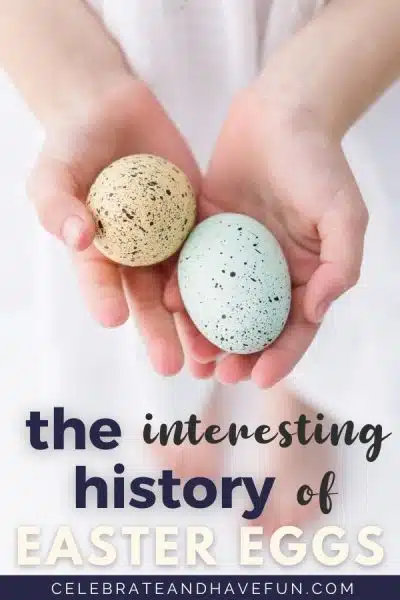A History Of Easter Eggs

Every year, Easter egg hunts pop up all over the country, from the White House to your house.
Have you ever wondered how it all got started?
How does a holiday that is a celebration of the resurrection of Christ and the birth of the Christian faith become involved with Easter eggs?
Note: This post may contain affiliate links, which means if you buy from my link I might make a small commission. This does not affect the price you pay. See the full affiliate disclosure here.
The history of Easter eggs is both varied and interesting.
Their history started long, long ago.
Mary Magdelene And The History Of Easter Eggs
Not originally meant as a means for children to have fun on Easter, folklore combines red Easter eggs with Mary Magdalene.
In one story, she is bringing eggs to split with the ladies as they waited at the tomb.
The eggs turned red as she saw the risen Christ.
In another tale, she approached the emperor of Rome to declare to him that Christ had risen.
Pointing to eggs on his table, the story continues, he rebuts Mary’s comment saying Christ had no more risen than the egg on his table was red. The egg, immediately, turned red.
Easter Eggs Became Part Of Christian Tradition
While folklore is fun, the truth about the origins of the Easter egg involves the egg’s connection with pagans.
Pope Gregory the Great was concerned with absorbing the local heathens into the Catholic church.
He told the missionaries to include as many festivals and customs of the local people as they could.
As many of the pagans celebrated the goddess of the Vernal Equinox and the goddess of dawn, Easter, the egg became a part of the Christian traditions too.
The cracked egg began to represent the broken tomb, the color red, the bloodshed on the cross.
People Began Giving Easter Eggs As Gifts
By 1290, Easter eggs were given as gifts. It is said that King Edward I once ordered 450 eggs to be decorated to give to his staff. They were covered in gold leaf after they were colored.
Ukrainian Easter eggs reach back to the pagan practices of the people in early history. In 988 AD, the acceptance of Christianity simply changed the focus of the eggs.
For example, the triangle that originally symbolized air, fire, and water now symbolizes the Trinity.
The Ukrainian egg is still popular today.
The giving of decorated eggs continued.
In 1885, Tsar Alexander III of Russia contacted Peter Carl Fabregé, to make a special Easter egg for his wife, Empress Maria Federovna. The gift was special because it reminded her of an egg,
The Hen Egg, that was owned by her aunt.
The Empress loved it so much it became a tradition.
Today, a Fabregé egg is synonymous with luxury.
Today’s Easter Eggs
Today, decorating eggs at Easter is completed in many different ways.
For years, you can mix vinegar with a tablet and dip the eggs.
Now you can put wraps around the eggs and dip them into hot water to seal them.
Crayon resistance, paint, and natural dyes are used for fancier eggs.
Time only knows what will happen next.
While you are here, I hope that you will check out my spring sprinkles hot cocoa bombs. They would be great to serve while dying Easter Eggs this year!







